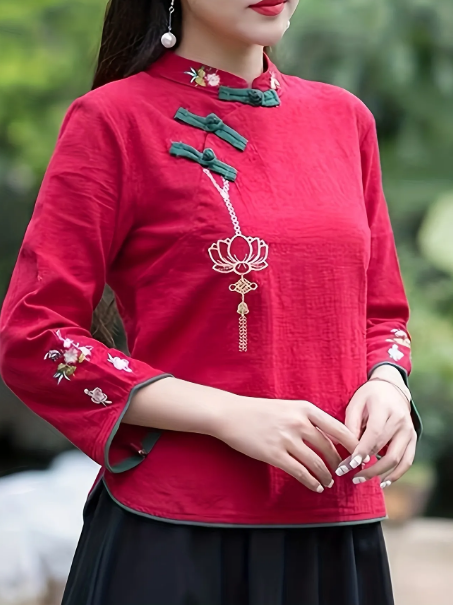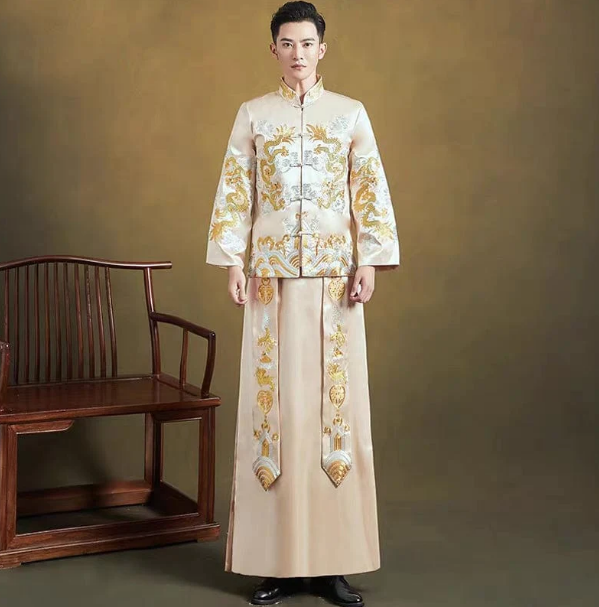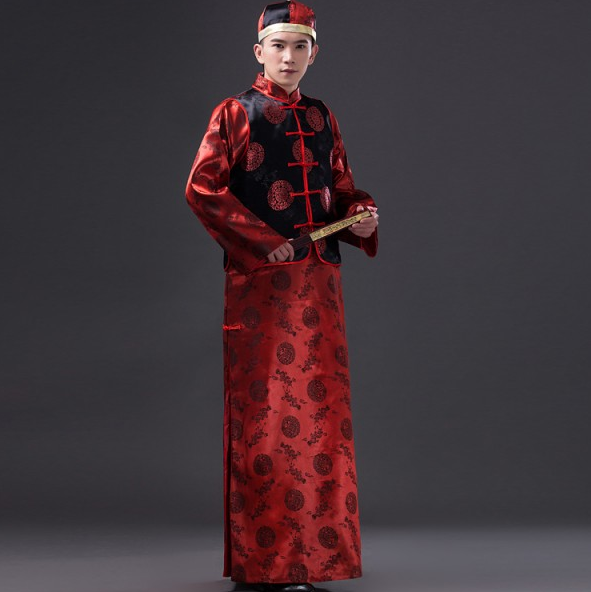Historical Background of the Tang Suit
The Tang Suit, known as “唐装” (Tángzhuāng) in Chinese, holds a rich historical legacy that spans centuries and reflects the cultural evolution of China. This traditional Chinese costume, with its distinctive style and design, embodies the essence of Chinese fashion heritage.
Origins of the Tang Suit
The Tang Suit finds its roots in the Tang Dynasty, which ruled China from 618 to 907 AD. During this period, it was common for people to wear clothing that featured a cross-collar and a right lapel, fastened with a button on the left side. This design was not only functional but also symbolized the balance and harmony emphasized in Chinese culture.
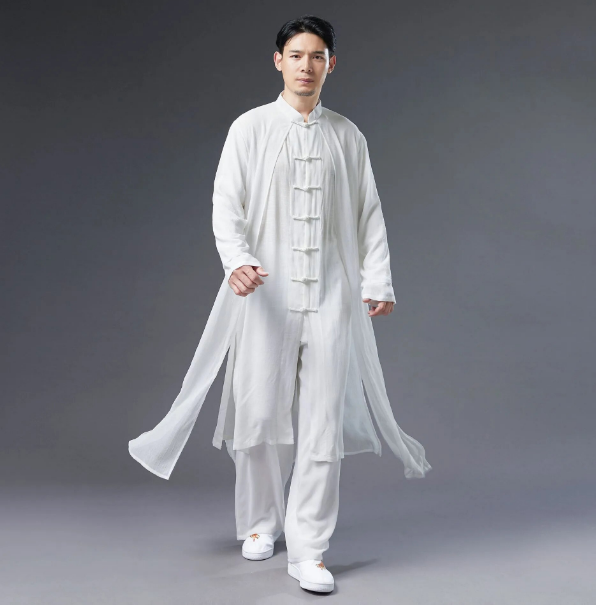
Historical Significance
- Cultural Integration (维基百科链接: Chinese Culture): The Tang Suit emerged as a result of cultural amalgamation during the Tang Dynasty. It incorporated elements from various ethnic groups, showcasing the diverse cultural landscape of China.
- Social Status and Identity: In ancient China, clothing was often used as a marker of social status and identity. The Tang Suit was worn by scholars, officials, and the elite, signifying their high rank and education.
- Functional Design (维基百科链接: Costume Design): The practicality of the Tang Suit’s design was favored by the working class. Its comfortable fit, ease of movement, and durability made it suitable for laborers and commoners.
- Symbolism (维基百科链接: Symbolism in Clothing): The choice of colors and patterns on the Tang Suit held symbolic meaning. Red, for example, represented good luck and happiness, while dragons symbolized power and strength.
Evolution Over Time
The Tang Suit continued to evolve through subsequent dynasties, adapting to changing fashion trends while retaining its fundamental characteristics. Modifications in materials, colors, and decorative elements reflected the aesthetics of each era.
- Ming and Qing Dynasties (维基百科链接: Ming Dynasty, Qing Dynasty): During these periods, the Tang Suit saw variations in sleeve length, collar styles, and fabric choices, catering to different social classes and occasions.
- Modern Revival (维基百科链接: Chinese Fashion): In the modern era, the Tang Suit experienced a revival in the early 20th century, with adaptations that combined traditional elements with contemporary fashion sensibilities.
Conclusion
The Tang Suit, with its deep historical roots, serves as a testament to China’s cultural diversity and its ability to adapt and evolve over time. Its enduring appeal continues to resonate in both traditional and modern fashion, making it a cherished icon of Chinese heritage.
Features and Characteristics of the Tang Suit
The Tang Suit, a quintessential traditional Chinese costume, is known for its distinctive design elements, choice of fabrics, and intricate motifs. These features have contributed to its enduring popularity and recognition.
Design Elements of the Tang Suit
- Cross-Collar (维基百科链接: Cross-Collar): The Tang Suit is characterized by its cross-collar design, where the right lapel overlaps the left. This design symbolizes balance and harmony in Chinese culture.
- Frog Buttons (维基百科链接: Frog Fasteners): The traditional Tang Suit is often adorned with frog buttons, which are knotted or toggle-style fasteners made of silk or other materials. These buttons not only serve a functional purpose but also add decorative flair.
- Straight-Cut Silhouette: The Tang Suit typically features a straight-cut silhouette that follows the natural lines of the body, providing a comfortable and flattering fit.
Choice of Fabrics
- Silk (维基百科链接: Silk): Historically, silk was the primary fabric used for crafting Tang Suits. Its luxurious texture and natural sheen made it a symbol of status and elegance.
- Cotton and Linen: In addition to silk, Tang Suits were also made from cotton and linen for practicality and comfort. These materials were more affordable and suitable for everyday wear.
Intricate Motifs and Embroidery
- Dragons (维基百科链接: Chinese Dragon): The dragon motif is a common feature on Tang Suits, symbolizing power, strength, and good fortune. Intricately embroidered dragons are often found on the chest, back, or sleeves.
- Floral Patterns: Tang Suits may also incorporate floral patterns, such as peonies or plum blossoms, representing beauty, prosperity, and endurance.
- Symbolism: The choice of motifs and colors on the Tang Suit often carries cultural and symbolic significance, conveying messages of luck, happiness, and prosperity.
Variations in Style and Occasions
- Formal vs. Casual Wear: Tang Suits come in various styles to suit different occasions. Formal Tang Suits are often made from finer materials with intricate embroidery, while casual ones may feature simpler designs.
- Men’s and Women’s Styles: Both men and women wear Tang Suits, with subtle differences in design and cut. Women’s Tang Suits may have more tailored and fitted silhouettes.
Quality and Craftsmanship
- Handcrafted vs. Mass-Produced: Traditional Tang Suits are often handcrafted with meticulous attention to detail, while modern variations may be mass-produced. Handcrafted Tang Suits are prized for their quality and authenticity.
- Price Range: The price of a Tang Suit can vary significantly based on factors like material, craftsmanship, and brand. High-quality silk Tang Suits can be quite expensive, while more affordable options are available.
Conclusion
The Tang Suit’s unique design elements, choice of fabrics, and intricate motifs showcase the craftsmanship and cultural significance of this traditional Chinese costume. Its adaptability to different occasions and continued popularity in modern fashion attest to its enduring appeal.
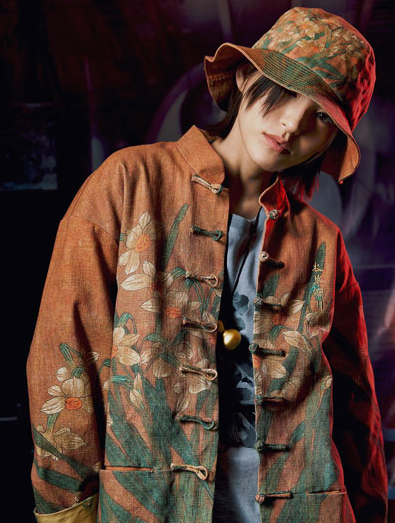
Evolution of the Tang Suit Over Time
The Tang Suit has undergone significant transformations throughout different historical periods, adapting to changing fashion trends, materials, and cultural influences. This evolution provides insight into the dynamic nature of Chinese fashion and its enduring appeal.
Tang Dynasty (618-907 AD)
- Origins of the Tang Suit: The Tang Suit originated during the Tang Dynasty, characterized by its cross-collar design and straight-cut silhouette. Silk was the primary material used, reflecting the dynasty’s prosperity.
Ming Dynasty (1368-1644 AD)
- Simplified Designs: During the Ming Dynasty, Tang Suits featured simplified designs with minimal embellishments. Commoners began to wear more affordable versions made from cotton or linen.
Qing Dynasty (1644-1912 AD)
- Influence of the Qing Manchu Dress (维基百科链接: Qing Dynasty Clothing): The Qing Dynasty introduced the use of the Manchu-style robe, which influenced the design of the Tang Suit. Robes with a front opening and distinctive collars became popular.
Early 20th Century
- Revival and Western Influence: In the early 20th century, the Tang Suit experienced a revival, with designers incorporating Western elements such as lapels, pockets, and buttons. This fusion of styles catered to changing tastes.
Late 20th Century
- Global Popularity: The late 20th century saw a resurgence of interest in traditional Chinese culture, leading to the global popularity of the Tang Suit. It became a symbol of Chinese identity and heritage.
Modern Times
- Contemporary Adaptations: Today, the Tang Suit continues to evolve with contemporary adaptations. Designers experiment with materials like silk blends, offering a balance between tradition and modernity.
Diverse Styles and Occasions
- Formal and Casual Wear: Tang Suits are now available in various styles for formal and casual occasions. Some are adorned with intricate embroidery, while others feature simpler designs.
Materials and Quality
- Silk Blends: While silk remains a popular choice, silk blends are often used to reduce costs while maintaining quality and comfort.
- Craftsmanship: Handcrafted Tang Suits are still highly valued for their attention to detail, but machine-made versions have become more common due to cost considerations.
Cultural Significance
- Symbol of Tradition: The Tang Suit remains a symbol of Chinese tradition, often worn during cultural events, festivals, and celebrations.
Conclusion
The evolution of the Tang Suit over different historical periods reflects not only changes in fashion but also shifts in cultural values and influences. Its ability to adapt while preserving its core elements highlights its enduring significance in the world of Chinese fashion.
Cultural Significance of the Tang Suit
The Tang Suit holds a prominent place in Chinese culture, symbolizing not only the nation’s rich history but also its values, aesthetics, and traditions. Its cultural significance can be observed in various contexts.
Symbol of Chinese Heritage
- Historical Continuity: The Tang Suit, rooted in the Tang Dynasty, represents China’s enduring cultural heritage. Its design elements and style have been passed down through generations.
- Patriotism: The Tang Suit is often associated with patriotism and a love for one’s country. It serves as a reminder of China’s historical achievements and contributions to the world.
Fashion and Identity
- Distinctive Aesthetics: The Tang Suit’s unique design, featuring the cross-collar and frog buttons, sets it apart as an iconic symbol of Chinese fashion.
- Cultural Identity: Wearing a Tang Suit can convey a strong sense of cultural identity and pride, both within China and among the Chinese diaspora worldwide.
Ceremonial and Festive Attire
- Traditional Celebrations: During cultural events, festivals, and traditional ceremonies like weddings and New Year’s celebrations, people often choose to wear Tang Suits as a mark of respect and adherence to tradition.
- Symbolism in Festivals (维基百科链接: Chinese New Year): For instance, during Chinese New Year, wearing a red Tang Suit is believed to bring good luck and ward off evil spirits.
Formal and Official Occasions
- Official Attire (维基百科链接: Chinese Diplomacy): Tang Suits are sometimes worn by government officials and diplomats on formal occasions, representing Chinese culture and values.
- Business and Leadership: In the corporate world, the Tang Suit can symbolize professionalism, leadership, and respect for tradition.
Cross-Cultural Exchange
- Global Recognition: Beyond China’s borders, the Tang Suit has gained international recognition as a symbol of Chinese culture. It often features in cultural exchange events and exhibitions.
- Cultural Diplomacy (维基百科链接: Cultural Diplomacy): The Tang Suit is used as a tool for cultural diplomacy, promoting understanding and appreciation of Chinese culture.
Contemporary Adaptations
- Modern Expression: The Tang Suit’s adaptability to modern fashion trends demonstrates its continued relevance in contemporary society.
- Fashion Industry (维基百科链接: Fashion Industry): Designers and fashion houses incorporate Tang Suit elements into their collections, further emphasizing its cultural significance.
Conclusion
The Tang Suit’s cultural significance goes beyond its status as traditional clothing. It serves as a symbol of China’s cultural identity, heritage, and values. Whether worn in formal settings, during celebrations, or as part of global cultural exchange, the Tang Suit plays a vital role in preserving and sharing the rich tapestry of Chinese culture with the world.
Modern Interpretations and Fashion Trends
In recent years, the Tang suit has experienced a resurgence in popularity, both in China and internationally. This revival can be attributed to various factors, including its timeless elegance and adaptability to contemporary fashion trends.
Contemporary Designs and Styles
Modern interpretations of the Tang suit have embraced a fusion of traditional elements with contemporary aesthetics. Designers have introduced innovative variations, such as asymmetrical cuts, bold color combinations, and intricate embroidery, to cater to diverse tastes.
Innovative Cuts and Silhouettes
Contemporary Tang suits often feature slim-fit designs that accentuate the wearer’s figure. These tailored fits offer a more modern and streamlined look compared to the looser traditional versions.
Color Palettes and Patterns
While classic Tang suits primarily utilize a subdued color palette of black, navy, and earthy tones, contemporary designs have expanded to include vibrant hues such as red, emerald green, and royal blue. Additionally, designers experiment with patterns, incorporating geometric shapes and abstract motifs.
Global Influence and Celebrity Endorsements
The Tang suit has gained recognition on the international stage, partly due to high-profile celebrities donning it at red-carpet events and in fashion magazines. This global exposure has contributed to its increased popularity among fashion enthusiasts worldwide.
Red-Carpet Appearances
Celebrities like Jackie Chan and Fan Bingbing have been spotted wearing Tang suits at international events, drawing attention to this traditional attire on a global scale.
Fashion Magazines and Editorials
Fashion magazines often feature editorial spreads showcasing modern interpretations of the Tang suit, helping it reach a wider audience and establish itself as a fashion-forward choice.
Rising Demand and Economic Impact
The growing demand for Tang suits has led to increased production and sales, benefiting both the fashion industry and the economy.
Production and Manufacturing
The production of Tang suits has become more streamlined and efficient, with manufacturers utilizing advanced machinery and production techniques to meet consumer demands.
Economic Contribution
The fashion industry’s embrace of the Tang suit has boosted job creation and contributed to economic growth in regions known for traditional costume production.
Sustainability and Ethical Considerations
As the fashion industry becomes more conscious of its environmental impact and ethical practices, some designers are incorporating sustainable materials and production methods into Tang suit manufacturing.
Sustainable Fabrics
Designers are increasingly using sustainable fabrics like organic cotton, hemp, and bamboo in Tang suit production to reduce the environmental footprint.
Ethical Sourcing
Ensuring fair wages and ethical working conditions for artisans involved in Tang suit production has become a priority for responsible fashion brands.
In conclusion, the Tang suit’s modern interpretations and fashion trends reflect its ability to adapt to the ever-changing landscape of the fashion industry. Its fusion of tradition and innovation, coupled with its global appeal, makes it a symbol of cultural heritage and contemporary style.
Debate on the Authenticity of the Tang Suit
The authenticity of the Tang suit as a truly traditional costume in modern times has been a subject of debate among scholars, historians, and cultural enthusiasts. While some argue that it has retained its traditional essence, others question its authenticity due to various factors.
Arguments in Favor of Authenticity
Cultural Heritage and Historical Significance
Proponents of the Tang suit’s authenticity emphasize its deep-rooted historical significance. They argue that the Tang suit is a symbol of China’s rich cultural heritage, dating back to the Tang Dynasty (618-907 AD). Its continued use in various ceremonies and festivals underscores its cultural value.
Preservation of Tradition
Advocates contend that the Tang suit plays a vital role in preserving Chinese traditions and customs. Its recognition as a traditional costume ensures that the legacy of the Tang Dynasty endures, making it an essential part of China’s cultural identity.
Craftsmanship and Artistry
Supporters point out that the craftsmanship and artistry involved in creating a Tang suit remain consistent with traditional techniques. Skilled artisans still use traditional methods to create intricate embroidery and patterns, preserving the garment’s quality and authenticity.
Arguments Against Authenticity
Evolution of Fashion
Critics argue that the Tang suit has evolved over time to adapt to changing fashion trends. They claim that contemporary Tang suits incorporate modern elements, such as slim-fit designs and bold colors, which deviate from the traditional loose-fitting, subdued attire of the Tang Dynasty.
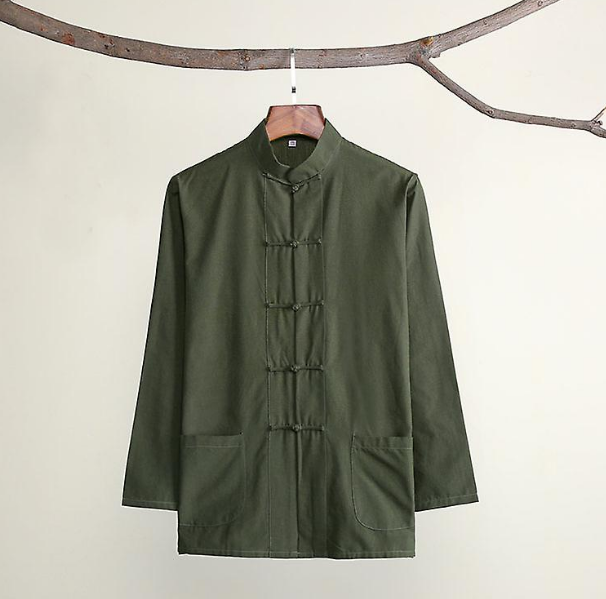
Commercialization and Mass Production
Detractors point to the commercialization and mass production of Tang suits as a reason for their diminished authenticity. The demand for affordable Tang suits has led to the use of lower-quality materials and reduced craftsmanship in some cases.
Influence of Western Clothing
Some critics contend that the influence of Western clothing has resulted in a hybridization of the Tang suit with Western fashion. This influence has led to the creation of Tang-style suits that may not align with the traditional definition of the costume.
The Middle Ground
While the debate on the authenticity of the Tang suit continues, there is a middle ground where compromise is sought. This perspective acknowledges the evolving nature of culture and fashion while also valuing the efforts made to preserve the traditional aspects of the Tang suit.
Modern Interpretations
Recognizing that fashion evolves, proponents of this middle-ground perspective appreciate modern interpretations of the Tang suit.
In conclusion, the debate surrounding the authenticity of the Tang suit reflects the ongoing tension between tradition and modernity. While some argue for strict adherence to tradition, others embrace the evolution of culture and fashion.
